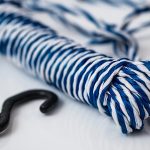If fabric is peeling off your instrument case, start by cleaning the area and trimming any loose edges. Use a strong, flexible fabric or vinyl adhesive for a lasting fix—apply it evenly and press the fabric firmly, then weigh it down while it dries. Avoid heat and moisture to prevent further damage. With careful repair and proper care, you can restore your case’s look and durability. Keep exploring to find tips on choosing adhesives and preventing future peeling.
Table of Contents
Key Takeaways
- Identify the peeling cause by inspecting moisture, wear, or heat damage to select the right repair approach.
- Clean the surface and trim loose fabric before applying a strong, flexible adhesive designed for fabric and plastic.
- Apply adhesive evenly on both fabric and case, press firmly, and secure with weights or clamps during drying.
- Choose fabric glue for ease and flexibility, or contact cement for a stronger, permanent bond with precise application.
- Prevent peeling by storing the case away from heat and moisture, handling gently, and regularly cleaning or protecting the fabric.
Identifying the Cause of Fabric Peeling
Before you can fix the fabric peeling off your instrument case, you need to understand what’s causing it.
Often, peeling results from moisture exposure, which weakens the adhesive holding the fabric. If your case has sat in damp places or faced rain, that’s likely the culprit.
Moisture exposure often weakens the adhesive, causing fabric to peel—especially if your case has been damp or rained on.
Another common cause is general wear and tear—constant handling and friction slowly break down the fabric’s surface.
Poor-quality materials or manufacturing defects can also lead to early peeling.
Sometimes, storing your case near heat sources dries out the fabric and glue, making them brittle.
Knowing the exact cause helps you choose the right repair method and prevent future damage.
Take a close look at your case’s environment and usage to pinpoint what’s behind the peeling fabric.
Assessing the Damage to Your Instrument Case
Evaluating the damage to your instrument case helps you determine the best repair approach.
Start by closely inspecting the peeling fabric area. Check if the fabric is lifting in small patches or large sections. Look for any tears, holes, or frayed edges that might complicate repairs. Feel the surface underneath the fabric to ascertain it’s still solid and not crumbling or warped.
Also, assess whether the adhesive is still sticky or completely dried out. If the peeling is minor and the base remains intact, a simple glue fix might work.
However, extensive damage or weakened structure could require more intensive repair or reinforcement. Taking note of these details will guide you in choosing the right method to restore your case effectively.
Gathering Materials and Tools Needed for Repair
Before you start fixing the peeling fabric, make sure you have the essential supplies like a clean cloth, scissors, and clamps.
Choosing the right adhesive is key—look for one that works well with fabric and the case material.
Having these tools ready will make the repair process smoother and more effective.
Essential Repair Supplies
You’ll need a few key supplies to fix the fabric peeling off your instrument case effectively.
Start with a clean cloth to wipe away dust and dirt from the affected area. Have a pair of sharp scissors ready to trim any loose or frayed fabric edges. A small brush or cotton swab will help you apply adhesive precisely without making a mess.
Keep some weights or heavy books nearby to press down the fabric while it dries, ensuring a secure bond. Additionally, gather some painter’s tape or clips to hold the fabric in place temporarily during the repair.
Finally, work on a flat surface with good lighting to see the details clearly and avoid mistakes. These essentials will set you up for a smooth, successful repair.
Selecting Proper Adhesives
Once you’ve gathered your basic repair supplies, choosing the right adhesive becomes the next step to guarantee the fabric sticks firmly and lasts.
Opt for a strong, flexible glue designed for fabric and plastic, like contact cement or a heavy-duty fabric glue. Avoid standard household glues—they won’t hold up to the stress and movement your instrument case faces.
If you’re dealing with vinyl or leather-like materials, a specialized vinyl adhesive works best. Make sure the adhesive dries clear to keep your case looking neat.
Also, check the drying time—some adhesives bond instantly, while others need pressure and time to set. Reading the label carefully will help you pick an adhesive that suits both the fabric type and your repair needs perfectly.
Cleaning the Surface Before Repair
Start by thoroughly cleaning the area where the fabric is peeling to guarantee a strong bond during repair. Dirt, dust, and oils can weaken the adhesive, so removing all contaminants is essential.
Here’s how to prep the surface effectively:
- Gently brush off loose dirt and debris with a soft cloth or brush.
- Use a mild soap solution and a damp cloth to clean stubborn grime.
- Avoid soaking the fabric; just lightly dampen it to prevent water damage.
- Let the area dry completely before proceeding.
- If there’s any sticky residue, try using rubbing alcohol on a cotton swab for spot cleaning.
Choosing the Right Adhesive for Your Case Fabric
You’ll want to pick an adhesive that matches your case fabric and holds up well over time.
Consider the strength needed to keep the fabric secure without damaging your instrument.
I’ll also share some tips to help you apply the glue cleanly and effectively.
Types of Adhesives
Choosing the right adhesive is essential when repairing fabric peeling off your instrument case, as different materials require different bonding strengths and drying times.
You want an adhesive that holds well without damaging your case or fabric. Here are some common types you might consider:
- Fabric glue: Specifically designed for fabrics, flexible and dries clear.
- Contact cement: Strong and durable, but requires careful application.
- Spray adhesive: Easy to apply evenly, ideal for large surfaces.
- Hot glue: Quick setting but may be too bulky for thin fabrics.
- Epoxy: Very strong, suitable for tough repairs but less flexible.
Adhesive Strength Considerations
Although selecting an adhesive might seem straightforward, understanding the strength needed for your instrument case fabric is essential to confirm a lasting repair.
You want an adhesive that holds firmly but won’t damage delicate materials. For heavy-duty fabrics or cases exposed to frequent handling, opt for a strong, flexible adhesive that withstands stress without cracking or peeling.
If your fabric is lightweight or delicate, choose a gentler adhesive that won’t soak through or cause discoloration.
Keep in mind that some adhesives bond better with synthetic fabrics, while others work best on natural fibers. Always check the adhesive’s specifications for compatibility with your case material.
Picking the right strength confirms your repair lasts, keeping your instrument safe and your case looking great.
Application Tips and Tricks
Applying adhesive properly can make all the difference in ensuring your instrument case fabric stays secure and looks neat.
Choosing the right adhesive depends on the fabric type and how much flexibility you need. You want a bond that’s strong but won’t damage your case.
Here are some tips to get it right:
- Use a fabric-specific adhesive like contact cement or fabric glue for durability.
- Test a small hidden spot first to check for discoloration or stiffness.
- Apply a thin, even layer to avoid lumps or excess glue seeping through.
- Press firmly and let it cure completely, following the glue’s instructions.
- Work in a well-ventilated area to avoid fumes and speed up drying time.
With these tricks, your case will look as good as new!
Step-by-Step Guide to Reattaching Peeling Fabric
To start reattaching the peeling fabric on your instrument case, gather a strong adhesive, a clean cloth, and a clamp or heavy books. First, clean any dirt or old glue from both surfaces with the cloth. Next, apply a thin, even layer of adhesive to the case and the fabric backing. Press the fabric firmly onto the case, smoothing out wrinkles or bubbles. Finally, secure the fabric with a clamp or place heavy books on top, letting it dry for several hours.
| Step | Action | Tip |
|---|---|---|
| 1 | Clean surfaces | Use a dry cloth to remove debris |
| 2 | Apply adhesive | Spread thinly and evenly |
| 3 | Press and clamp | Avoid wrinkles, dry thoroughly |
Using Fabric Glue vs. Contact Cement: Pros and Cons
When choosing between fabric glue and contact cement, you’ll want to contemplate how strong the bond needs to be and how easy the glue is to apply.
Fabric glue often dries faster and is simpler to work with, but contact cement usually offers a stronger hold.
Understanding these differences will help you pick the best adhesive for your instrument case repair.
Adhesion Strength Comparison
Although both fabric glue and contact cement can secure your instrument case fabric, their adhesion strengths differ considerably.
Fabric glue offers a strong bond that’s flexible and ideal for delicate materials, but it may weaken over time with heavy use.
Contact cement provides a more robust, permanent hold, perfect for heavy-duty repairs, yet it can be less forgiving if you need to reposition the fabric.
Consider these points:
- Fabric glue is less likely to damage delicate fabric fibers.
- Contact cement creates a nearly instant, strong bond.
- Fabric glue remains slightly flexible after drying.
- Contact cement forms a rigid bond that resists peeling.
- Fabric glue might require multiple applications for maximum strength.
Choose based on how tough and permanent you want the fix to be.
Application Ease Differences
Since you want a quick and manageable repair, understanding the application ease of fabric glue versus contact cement is essential.
Fabric glue is user-friendly—you simply squeeze it onto the fabric or case, spread it evenly, and press. It’s forgiving if you make a small mistake since you can clean up excess with a damp cloth before it dries.
On the other hand, contact cement requires more precision. You need to apply it to both surfaces, wait until it becomes tacky, then carefully align and press them together. It’s less forgiving because once they touch, repositioning is tough.
If you’re not confident about precision or want less mess, fabric glue is your best bet. But if you want a stronger bond and can handle careful application, contact cement works well.
Drying Time Impact
Because you want your instrument case back in use quickly, drying time plays a crucial role in choosing between fabric glue and contact cement.
Fabric glue usually dries slower, often needing 24 hours to fully set, but it remains flexible, which is great for fabric movement.
Contact cement, on the other hand, bonds almost instantly after application but requires careful alignment since repositioning is tough.
Consider these drying time impacts:
- Fabric glue lets you adjust pieces before it dries.
- Contact cement demands precise placement from the start.
- Quick bonding with contact cement speeds up repairs.
- Fabric glue’s slower drying means a longer wait but less risk.
- Both adhesives reach full strength after about 24 hours.
Choose based on how fast you need your case ready and your comfort with handling the glue.
How to Smooth Out Wrinkles and Bubbles During Repair
When you notice wrinkles and bubbles forming while repairing your instrument case fabric, act quickly to smooth them out before the adhesive sets.
Use a clean, flat tool like a plastic card or a small roller to gently press the fabric from the center outward. This pushes trapped air and excess glue toward the edges, eliminating bubbles and flattening wrinkles.
Be careful not to stretch the fabric too much, as this can cause distortion or new creases. If needed, lift the fabric gently and reposition it to release stubborn bubbles, then press down again.
Work patiently and methodically, ensuring the fabric lies flat and smooth. Addressing these imperfections early guarantees a professional-looking repair and extends your case’s durability.
Tips for Preventing Future Fabric Peeling
Taking the time to smooth out wrinkles and bubbles during your repair sets a solid foundation for lasting results.
To keep your instrument case fabric intact longer, you need to be proactive. Here are some tips to prevent future peeling:
- Store your case away from direct sunlight and extreme heat to avoid fabric weakening.
- Keep the case dry; moisture can loosen adhesives and damage fabric.
- Handle your case gently, avoiding sharp edges or rough surfaces that can cause abrasion.
- Regularly clean the fabric with a soft brush or cloth to remove dirt and oils.
- Apply a fabric protectant spray designed for your case material to add an extra barrier.
Following these steps will help maintain your repair and keep your instrument case looking great for years.
When to Consider Professional Repair Services
If your instrument case’s fabric damage goes beyond simple peeling or your repair attempts haven’t held up, it’s time to think about professional help.
Professionals have the tools and expertise to handle extensive fabric damage, structural issues, or delicate materials that DIY fixes can’t properly address.
If you notice underlying damage to the case’s padding or frame, a pro can guarantee it’s restored without compromising protection.
Also, if your case is valuable or vintage, professional repair preserves its integrity and value.
Don’t hesitate to consult a specialist if you’re unsure about the extent of the damage or if your fixes keep failing.
Investing in expert repair saves you time and prevents further deterioration, keeping your instrument safe and your case looking great.
Alternative Solutions: Using Fabric Patches or Covers
Sometimes professional repair isn’t an option due to cost or timing, so exploring alternative solutions can help you manage fabric peeling on your instrument case.
Using fabric patches or covers is a practical way to extend your case’s life and keep it looking decent. You can customize your case while covering damaged areas effectively.
Here’s how you can approach it:
- Choose durable fabric patches that match or complement your case.
- Use fabric glue or sew patches for a secure hold.
- Consider adhesive-backed fabric covers for easy application.
- Trim patches neatly to avoid fraying edges.
- Opt for waterproof or stain-resistant materials for extra protection.
These alternatives allow you to fix your case quickly without professional help, keeping your instrument safe and stylish.
Caring for Your Instrument Case After Repair
Once you’ve repaired your instrument case, maintaining its condition will help prolong its lifespan and keep your instrument protected.
Regularly clean the case using a soft brush or cloth to remove dust and dirt that can wear down the fabric. Avoid exposing the case to excessive moisture or direct sunlight, as these can cause fading and weaken adhesives.
Store your case in a cool, dry place when not in use. Handle it gently, especially around repaired areas, to prevent new damage.
If you notice any peeling starting again, address it promptly to avoid bigger repairs.
Frequently Asked Questions
What Types of Instrument Cases Are Most Prone to Fabric Peeling?
Imagine you own a vintage violin case with fabric glued over wood. You’re likely to see peeling because soft, glued fabrics on older or cheaper cases tend to degrade faster, especially with frequent handling or moisture exposure.
Can Temperature Changes Cause Fabric Peeling on Instrument Cases?
Yes, temperature changes can cause fabric peeling on instrument cases. When materials expand and contract due to heat or cold, adhesives weaken, making the fabric more likely to separate. You’ll want to store your case in stable conditions.
How Long Does It Typically Take for Fabric Glue to Dry?
It typically takes fabric glue about 24 hours to fully dry and set, but you’ll notice it becoming tacky within 30 minutes to an hour. Make sure to let it cure completely for the best hold.
Is Fabric Peeling a Common Issue With Vintage Instrument Cases?
You might be surprised, but yes, fabric peeling is quite common with vintage instrument cases. Over time, adhesives weaken and materials degrade, so if your case is older, you’ll likely face this issue sooner or later.
Are There Eco-Friendly Adhesives Suitable for Repairing Instrument Cases?
You can use eco-friendly adhesives like natural rubber cement or water-based glues to repair your instrument case. They’re non-toxic, biodegradable, and strong enough to keep the fabric intact without harming the environment.
- Does Chiffon Fabric Stink - July 15, 2025
- Does Chiffon Fabric Affect the Economy - July 15, 2025
- Does Cotton Fabric Have a Nap - July 15, 2025







